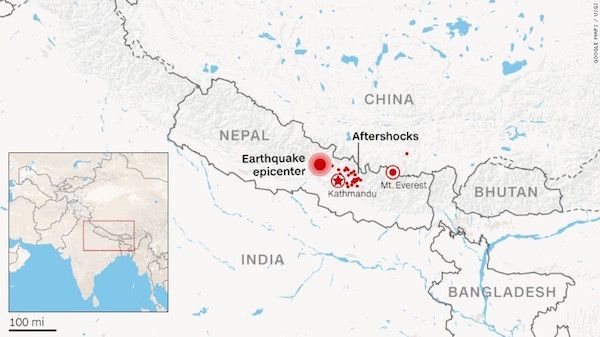
A magnitude 6.7 aftershock earthquake has just hit the devastated Nepal after yesterday’s history making quake. This occurred all while rescue workers were scrambling to find survivors and bodies amongst the rubble of yesterday’s super-quake. Mountain climbers on Everest reported feeling the aftershock, as well as spotting avalanches and rock slides.
Rescue crews and residents in Nepal early Sunday began the desperate search for survivors after a magnitude-7.8 quake near the capital of Kathmandu a day earlier flattened homes, buildings and temples, causing widespread damage across the region and killing more than 1,900 people.

BYPASS THE CENSORS
Sign up to get unfiltered news delivered straight to your inbox.
You can unsubscribe any time. By subscribing you agree to our Terms of Use
Whole streets and squares in the capital of more than 1 million people were covered in rubble. Stunned residents stared at temples that were once part of their daily lives and now were reduced to nothing.
Locals and tourists ferreted through mounds of debris in search of survivors. Cheers rose from the piles when people were found alive — but mostly bodies turned up. The injured ended up being treated outside overflowing hospitals, where crowds of people gathered looking for relatives.
Dozens of bodies were pulled from the historic nine-story Dharahara tower that came crashing down during the quake. At least 17 people were reported killed on Mount Everest, where the quake caused multiple avalanches.

A seemingly endless series of aftershocks continued to roil the area, further traumatizing survivors. Residents huddled in the cold rain overnight for safety.
The death toll of 1,910 — provided Sunday by Laxmi Dhakal, an official at the Nepalese Ministry of Home Affairs — is expected to rise as the full extent of the damage is assessed.
The loss of life reported so far “is really based on the information we have from the main cities,” Lex Kassenberg, Nepal country director for CARE International, told CNN. “But if you look at the spread of the earthquake a lot of the rural areas have been hit as well. The information we received from the field is that 80% of the houses in these rural areas have been destroyed.”
News out of remote areas near the quake’s epicenter, where many more may have died, has been scant. Most of the homes in the secluded Latang Valley, have been destroyed an official there said.
In accessible cities, many hills of rubble have yet to reveal all the bodies of people inside of buildings, when they collapsed.
The quake was the strongest in the region in more than 80 years. Residents are used to earthquakes in Nepal, and many thought the start of Saturday’s quake was a tremor, until the earth kept shaking and buildings crashed down.
“The reports of the devastation are still coming in and the numbers of people killed, injured and affected by this earthquake continue to rise,” said U.N. Secretary-General Ban Ki-moon in a statement. “It is clear that very many lives have been lost.”
An estimated 4.6 million people in the region were exposed to tremors from the Nepal earthquake, the United Nations Office for the Coordination of Humanitarian Affairs said via Twitter. Thirty out of 75 Nepal districts were affected by the quake.
In neighboring Tibet, roads buckled, buildings collapsed and at least 13 people were killed, China’s state media reported, citing local authorities.
Separately, at least four Chinese citizens in Nepal — two workers with a Chinese company, a tourist and a mountaineer — have been killed, state media reported, citing the Chinese Embassy in Kathmandu.
Officials in India confirmed at least 34 deaths in three states from the Nepal quake.
The quake struck at 11:56 a.m. local time (2:11 a.m. ET) and was centered less than 50 miles northwest of Kathmandu. It occurred at a depth of 9.3 miles, which is considered shallow and more damaging than a deeper quake. It was reported by people in the area as having lasted a long time. One person said he felt as if he were on a ship in rough seas.
Kathmandu sits in a valley surrounded by the Himalayas.
Siobhan Heanue, a reporter with ABC News Australia, told CNN she was wandering at an ancient temple complex at the moment of the earthquake. Several temples collapsed around her, she said.
“It’s not too often you find yourself in a situation where you have to run for your life,” Heanue said, adding that she sought shelter under the table of a cafe. “It was utterly terrifying.”


